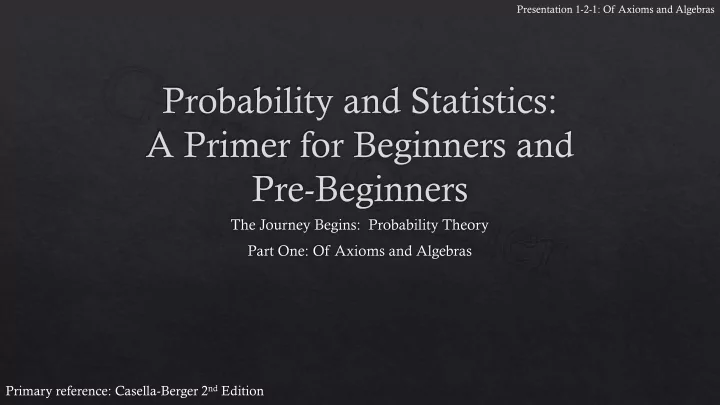

Presentation 1-2-1: Of Axioms and Algebras Primary reference: Casella-Berger 2 nd Edition
Presentation 1-2-1: Of Axioms and Algebras Ω (the sample space) And in it were… (of an experiment) …déjà vu? 2
Presentation 1-2-1: Of Axioms and Algebras If you rolled a die with these six faces 100 times… …you might expect a different outcome than you’d get from one with these six faces. So maybe probability could be interpreted in terms of the frequency of occurrence of certain outcomes of an experiment? 3
Presentation 1-2-1: Of Axioms and Algebras How many times can you repeat an election? So maybe interpretation of probability is more subjective? 4
Presentation 1-2-1: Of Axioms and Algebras We don’t need no stinking context when we got cold, hard axioms! For now, we don’t need to interpret probabilities, we just gotta make sure they follow the rules. 5
Presentation 1-2-1: Of Axioms and Algebras But before we can talk about the axioms of probability, first we need to talk about parallel universes. (nah just sigma algebras) 6
Presentation 1-2-1: Of Axioms and Algebras First, it gets a fancy letter: ℬ Second, it’s a term for a collection of subsets of our sample space Ω that has special properties! 7
Presentation 1-2-1: Of Axioms and Algebras a. ∅ ∈ ℬ : It ain’t a Borel field unless the empty set is an element! b. For any set 𝐵 , if 𝐵 ∈ ℬ , then 𝐵 𝐷 ∈ ℬ . Remember, 𝐵 𝐷 is the complement of A! This property is known as being closed under complementation ! c. If sets 𝐵 1 , 𝐵 2 , 𝐵 3 , … ∈ ℬ , then ∞ 𝐵 𝑗 ∈ ℬ ڂ 𝑗=1 This property is known as being closed under countable unions ! 8
Presentation 1-2-1: Of Axioms and Algebras a. ∅ ∈ ℬ So the empty set is in ℬ . Big deal, right? ∅ is a subset of every set. But, ∅ = Ω 𝑑 , and rule b. said ℬ had to be closed under complementation ! So now Ω is always in ℬ , too! 9
Presentation 1-2-1: Of Axioms and Algebras c. If sets 𝐵 1 , 𝐵 2 , 𝐵 3 , … ∈ ℬ , then ∞ 𝐵 𝑗 ∈ ℬ ڂ 𝑗=1 Oh boy, things get tricky for a bit. By rule b. (closed under ∞ 𝐵 𝑗 𝐷 ∈ ℬ too! Plus, 𝐵 1 𝐷 , 𝐵 2 𝐷 , 𝐵 3 𝐷 , … ∈ ℬ . complementation), ڂ 𝑗=1 ∞ 𝐵 𝑗 𝐷 ∈ ℬ , and a final Applying rule c. once more means ڂ 𝑗=1 𝐷 𝐷 ∈ ℬ ! ∞ 𝐵 𝑗 application of rule b. means ڂ 𝑗=1 (is the room spinning, or just my head?!) 10
Presentation 1-2-1: Of Axioms and Algebras Remember DeMorgan’s Law? It states that for any sets 𝐵 1 and 𝐵 2 , 𝐷 ∩ 𝐵 2 𝐷 . ( 𝐵 1 ∪𝐵 2 ) C = 𝐵 1 Well, that law can be shown to prove that 𝐷 𝐷 =ځ 𝑗=1 ∞ 𝐵 𝑗 ∞ 𝐵 𝑗 , so now the intersection of all those sets is by ڂ 𝑗=1 definition an element of ℬ . 11
Presentation 1-2-1: Of Axioms and Algebras 1. ∅ ∈ ℬ 2. Ω ∈ ℬ 3. If sets 𝐵 1 , 𝐵 2 , 𝐵 3 , … ∈ ℬ , ∞ 𝐵 𝑗 ∈ ℬ a) ڂ 𝑗=1 ∞ 𝐵 𝑗 𝐷 ∈ ℬ b) ڂ 𝑗=1 𝐷 , 𝐵 2 𝐷 , 𝐵 3 𝐷 , … ∈ ℬ c) 𝐵 1 ∞ 𝐵 𝑗 𝐷 ∈ ℬ d) ڂ 𝑗=1 𝐷 𝐷 =ځ 𝑗=1 ∞ 𝐵 𝑗 ∞ 𝐵 𝑗 ∈ ℬ e) ڂ 𝑗=1 12
Presentation 1-2-1: Of Axioms and Algebras For all of that misery, we’re only interested in the smallest Borel field that contains all the open sets of Ω . If the elements of Ω are finite or at least countable, then this is just all the subsets of Ω , including Ω itself. 13
Presentation 1-2-1: Of Axioms and Algebras Ok, so let’s define a little sample space again, and figure out which sets go into our Borel field. Ω = {x, y, z} 5. {z} 1. ∅ 2. {x, y, z} 6. {x, y} 3. {x} 7. {x, z} 4. {y} 8. {y, z} 14
Presentation 1-2-1: Of Axioms and Algebras …you don’t want to know. 15
Presentation 1-2-1: Of Axioms and Algebras And so you shall, my friend! For now, I shall unveil to you Kolmogorov’s axioms of probability, though only to whet your appetite for the decadent mathematical pleasures yet to come! Now for the moment you’ve been waiting for, here they are! 16
Presentation 1-2-1: Of Axioms and Algebras 1. P( 𝐵 ) ≥ 0 for all 𝐵 ∈ ℬ 2. P( Ω ) = 1 3. If sets 𝐵 1 , 𝐵 2 , 𝐵 3 , … ∈ ℬ are pairwise disjoint, ∞ 𝐵 𝑗 ) = σ 𝑗=1 ∞ 𝑄(𝐵 𝑗 ) then P( ڂ 𝑗=1 (okay bye) 17
Recommend
More recommend